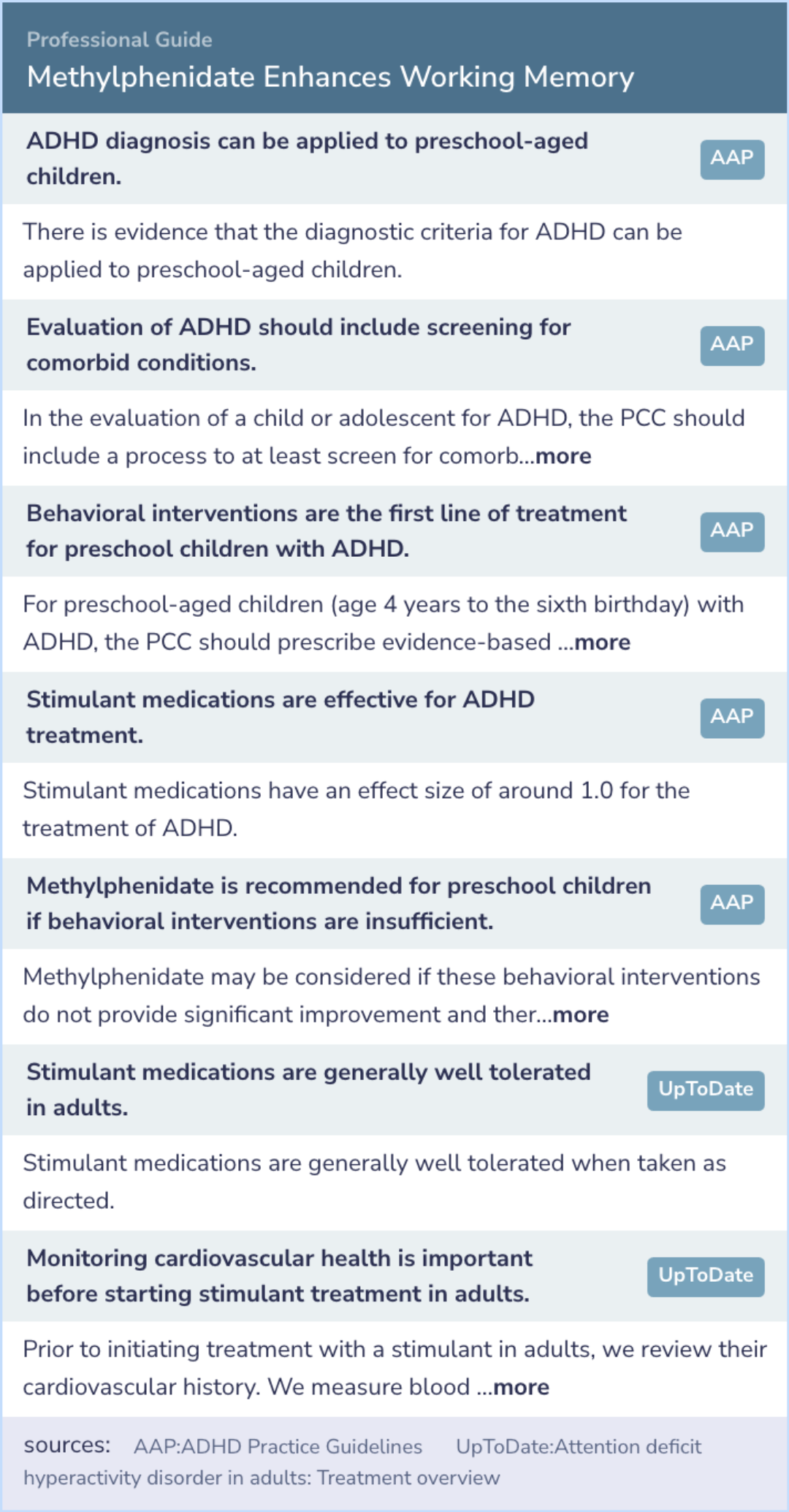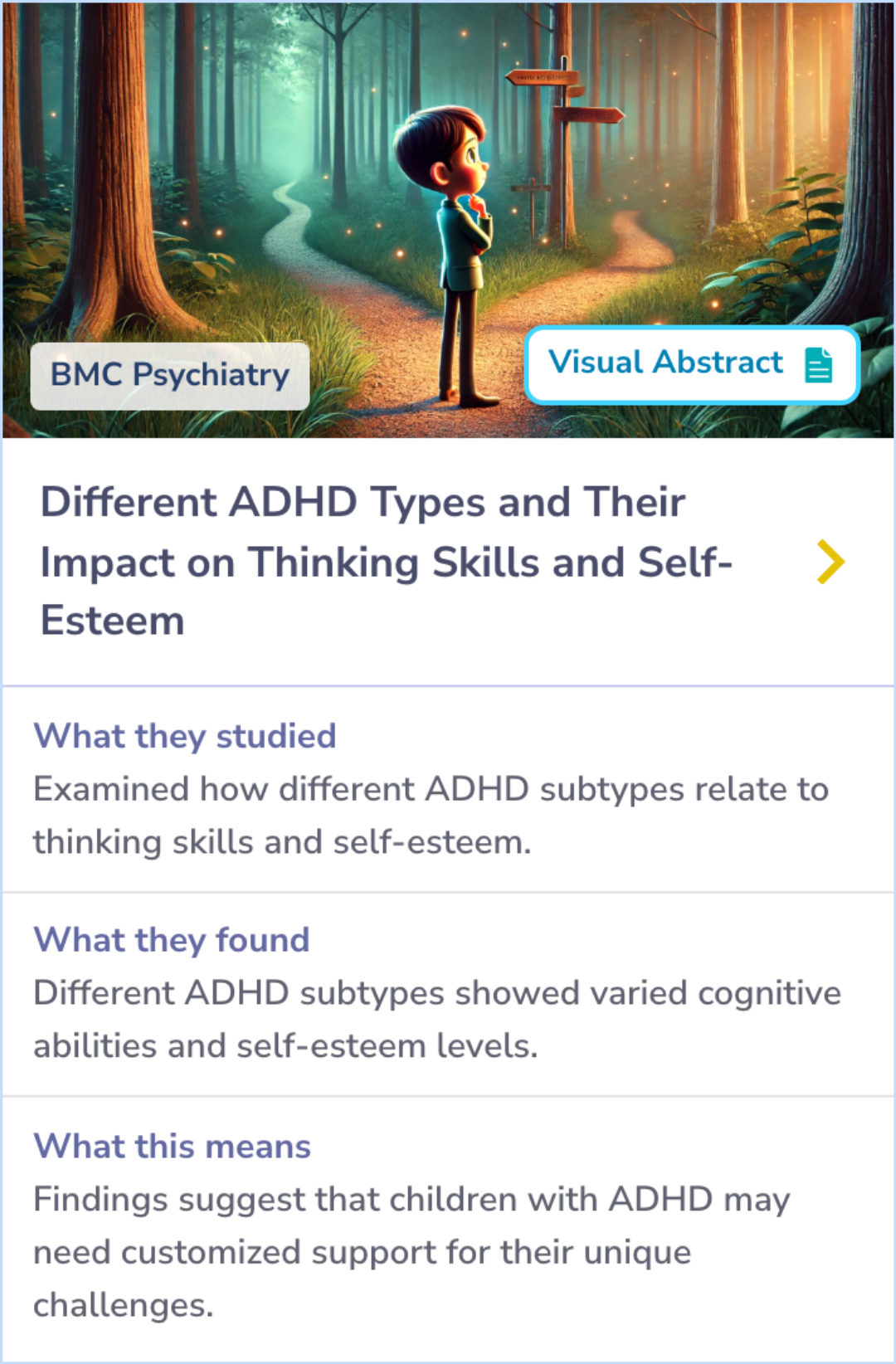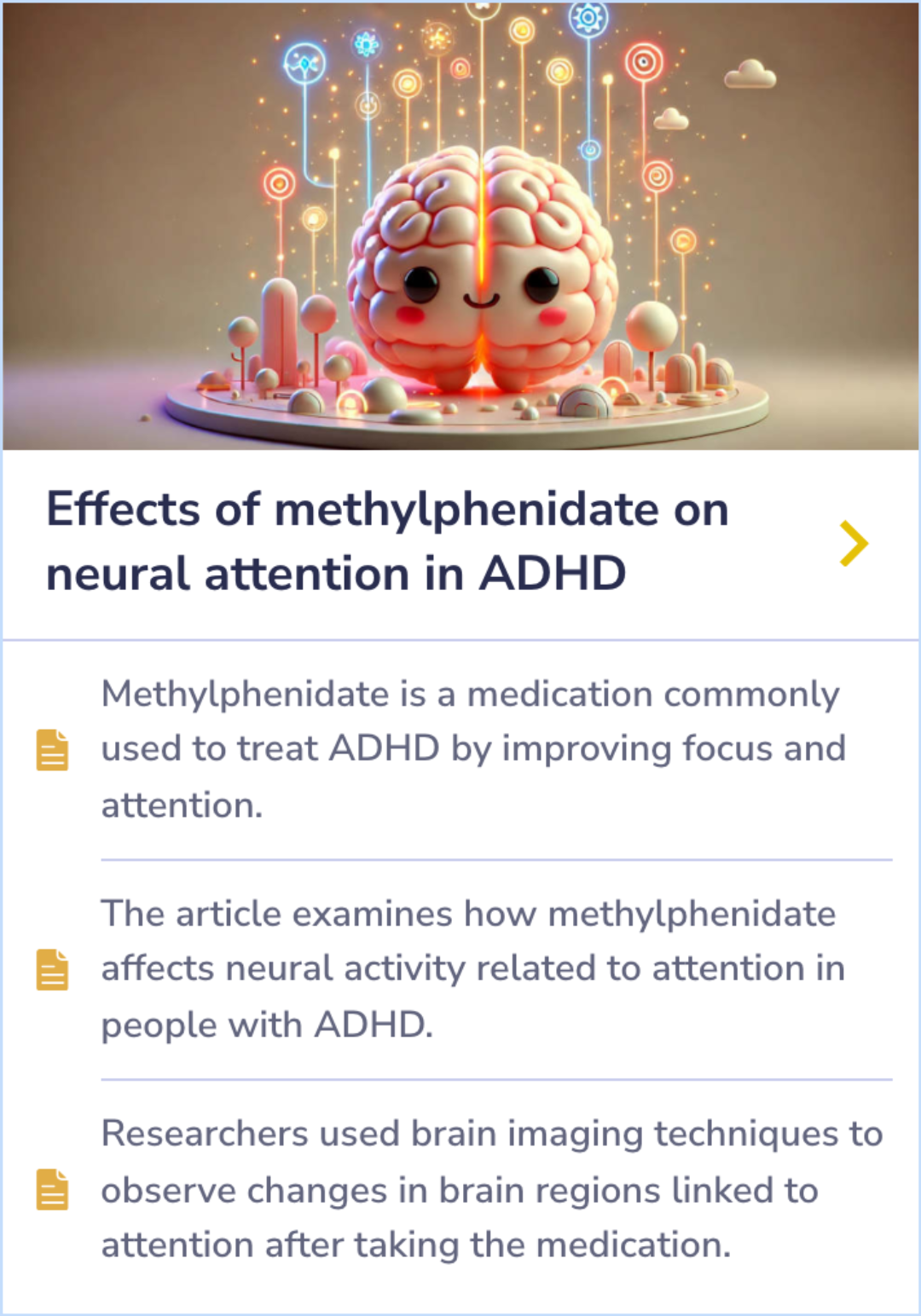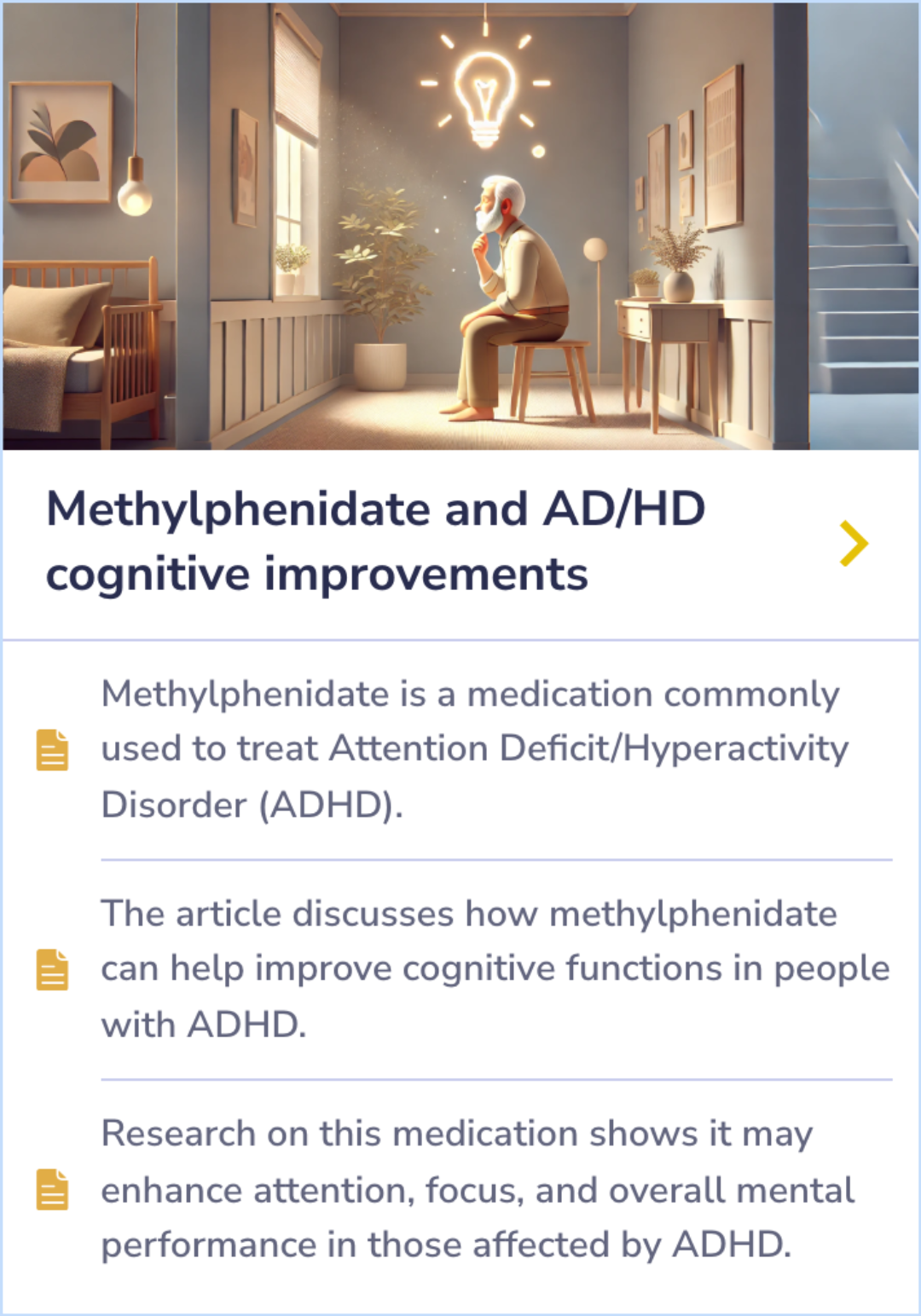Ritalin Paper Database
Visual Abstract
Methylphenidate enhances working memory by modulating discrete frontal and parietal lobe regions in the human brain
Methylphenidate (Ritalin) Reduces Brain Activity to Improve Working Memory
October 17, 2024
author
Mehta MA, Owen AM, Sahakian BJ, Mavaddat N, Pickard JD, Robbins TW
journal
J Neurosci
Date Published
2000 Mar 15
Why link to a visual abstract?
What is a visual abstract?
Original
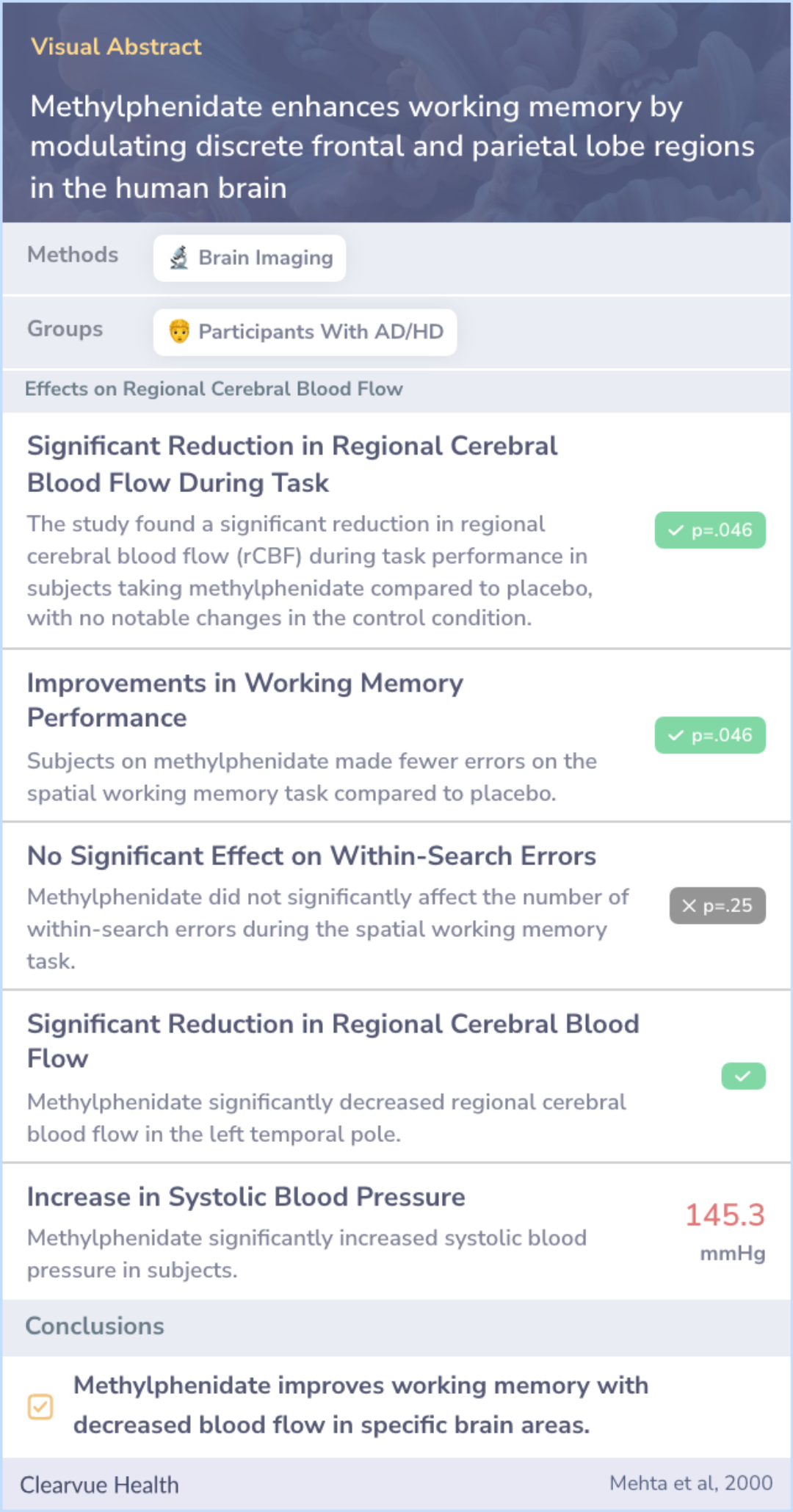
Study Summary
🔬
What They Studied
The study examined how methylphenidate (Ritalin) affects brain activity and working memory.
💡
What They Found
Methylphenidate (Ritalin) improved working memory and reduced blood flow in specific brain regions.
📚
What This Means
These findings suggest that methylphenidate (Ritalin) can help improve working memory, especially for those with lower initial capacity, by targeting certain areas of the brain.
Study Summary
Study Overview
Methylphenidate is a stimulant medication used mainly to treat ADHD and narcolepsy.
It enhances performance on spatial working memory tasks, which has been linked to changes in brain activity in specific areas.
This drug works by increasing levels of important brain chemicals that affect focus and memory.
Research shows that its benefits are more noticeable in individuals with lower starting memory abilities.
It is vital for parents and caregivers to monitor its use, given its potential effects on heart health and growth in children.
Understanding its mechanisms aids in acknowledging its positive effects in treating cognitive disorders.
It enhances performance on spatial working memory tasks, which has been linked to changes in brain activity in specific areas.
This drug works by increasing levels of important brain chemicals that affect focus and memory.
Research shows that its benefits are more noticeable in individuals with lower starting memory abilities.
It is vital for parents and caregivers to monitor its use, given its potential effects on heart health and growth in children.
Understanding its mechanisms aids in acknowledging its positive effects in treating cognitive disorders.
Abstract: background
The indirect catecholamine agonist methylphenidate (Ritalin) is the drug treatment of choice in attention deficit/hyperactivity disorder (AD/HD), one of the most common behavioral disorders of childhood (DSM-IV), although symptoms may persist into ad...more

Mechanism of Memory Enhancement
"These findings provide valuable insights into the mechanism of enhancement of SWM performance by the catecholaminergic stimulant drug methylphenidate."
Understanding Cognitive Disorders
"These results have important consequences for understanding the methylphenidate-induced improvements seen in children with AD/HD on working memory tasks."
Broader Implications
"More generally, the results are important for understanding the possible beneficial effects of catecholaminergic drugs in a range of cognitive disorders, including acute brain injury and schizophrenia."
Study Summary
Methods
The study explored how methylphenidate affects regional cerebral blood flow (rCBF) while participants performed a self-ordered spatial working memory (SWM) task. The goal was to pinpoint which areas of the brain are influenced by the drug, helping to clarify how it improves cognitive performance.
Participants were monitored to see how their brain activity changed during the task after taking methylphenidate. Specifically, the focus was on identifying any alterations in blood flow in different regions of the brain as a result of the medication.
Participants were monitored to see how their brain activity changed during the task after taking methylphenidate. Specifically, the focus was on identifying any alterations in blood flow in different regions of the brain as a result of the medication.
Abstract: methods
The present study investigated changes in regional cerebral blood flow (rCBF) induced by methylphenidate during performance of a self-ordered SWM task to define the neuroanatomical loci of the beneficial effect of the drug.

Study Summary
Results
The study found that participants who took methylphenidate showed improved performance on working memory tasks. This improvement was associated with a decrease in regional cerebral blood flow (rCBF) in the dorsolateral prefrontal cortex and the posterior parietal cortex.
These beneficial effects were most notable in individuals who initially had lower working memory capacities. Essentially, the drug seemed to help those with weaker working memory abilities more than those who started with stronger abilities.
These beneficial effects were most notable in individuals who initially had lower working memory capacities. Essentially, the drug seemed to help those with weaker working memory abilities more than those who started with stronger abilities.
Abstract: results
The results show that the methylphenidate-induced improvements in working memory performance occur with task-related reductions in rCBF in the dorsolateral prefrontal cortex and posterior parietal cortex. The beneficial effects of methylphenidate on ...more
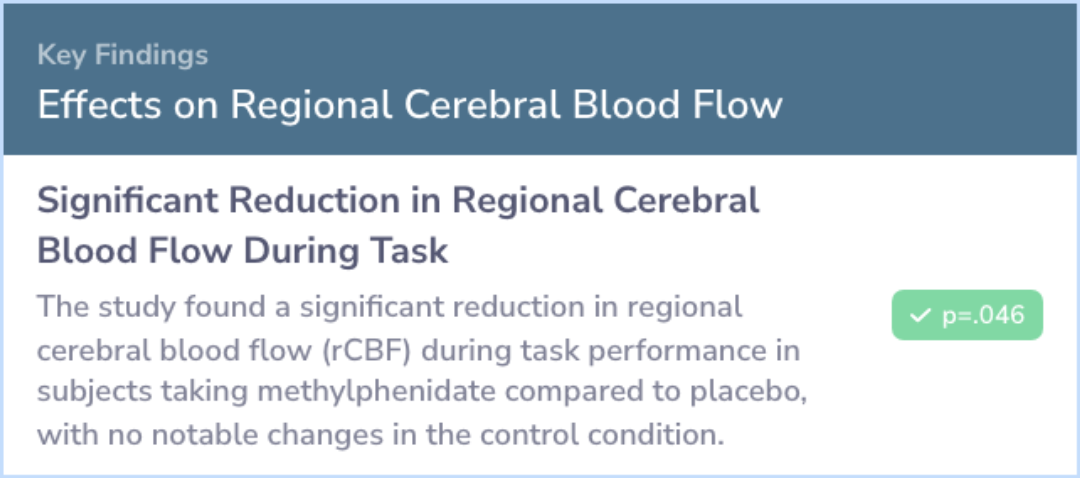
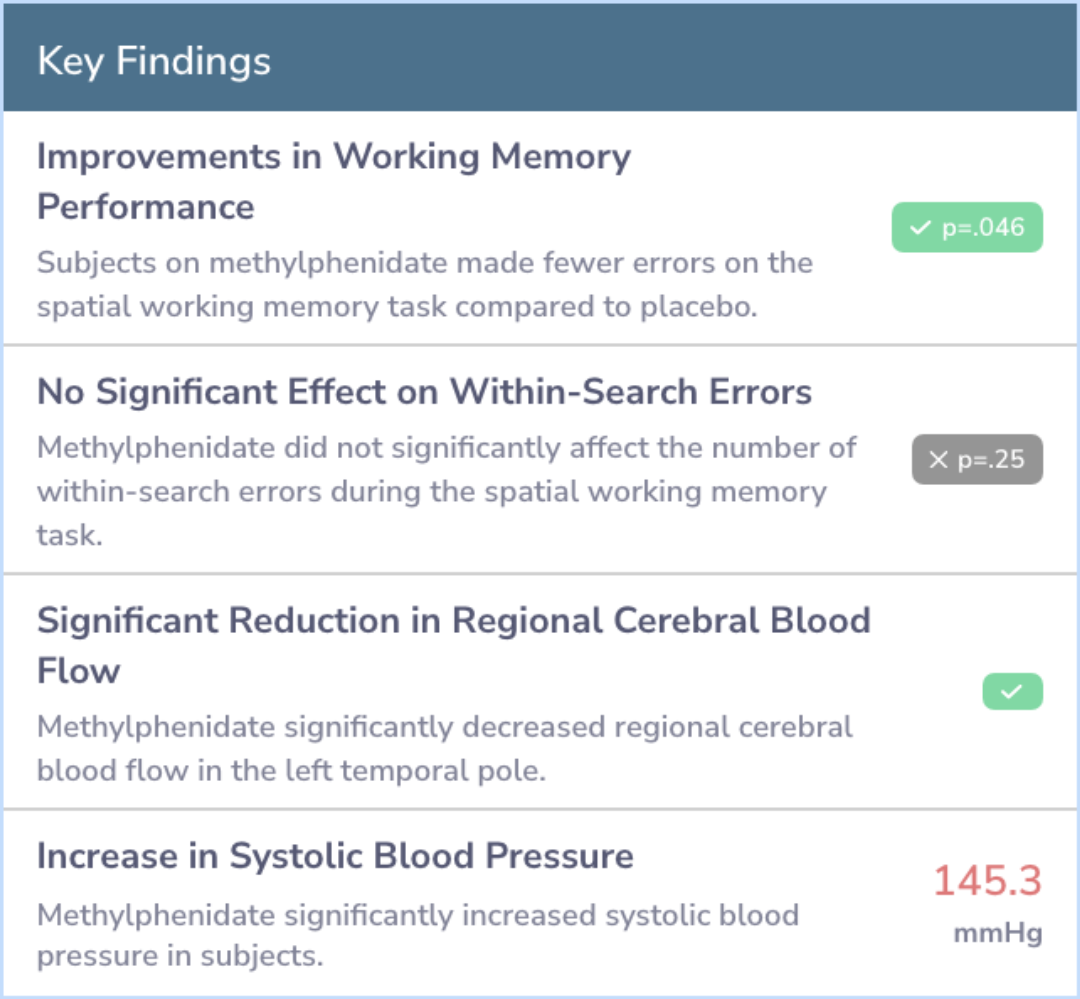
Study Summary
Conclusions
This study is the first to identify specific brain regions linked to the improvement in spatial working memory performance induced by methylphenidate in humans. The findings offer important insights into how methylphenidate works to treat symptoms of AD/HD.
This information could enhance our understanding of the neuroanatomical basis for the effectiveness of AD/HD treatments, possibly leading to better therapeutic strategies in the future.
This information could enhance our understanding of the neuroanatomical basis for the effectiveness of AD/HD treatments, possibly leading to better therapeutic strategies in the future.
Abstract: conclusions
This is to our knowledge the first demonstration of a localization of a drug-induced improvement in SWM performance in humans and has relevance for understanding the treatment of AD/HD.
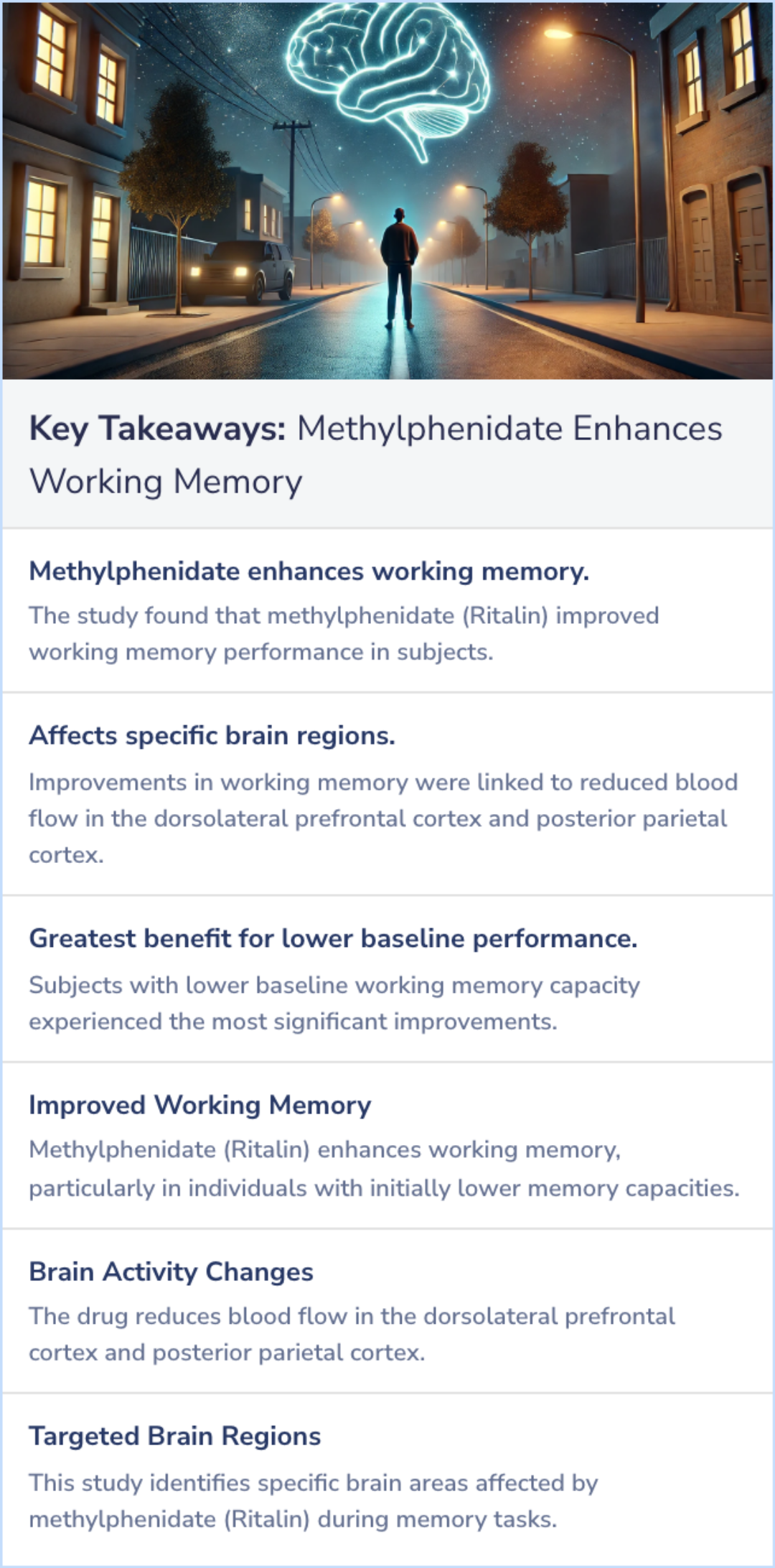
Background Information
Patient Guide
👨⚕️
Methylphenidate's Primary Uses
Methylphenidate is FDA-approved for treating ADHD in children and adults and as a second-line treatment for narcolepsy.
🧠
Mechanism of Action
Methylphenidate increases norepinephrine and dopamine concentration by blocking their reuptake in the synaptic cleft.
🧠
Effect on Cognitive Performance
It enhances cognitive performance in tasks sensitive to frontal lobe damage, like spatial working memory.
💊
Different Formulations Available
Available as immediate-release, extended-release, sustained-release tablets, chewable tablets, solutions, and transdermal patches.
🚨
Monitoring and Risks
Regular monitoring for side effects and potential abuse is mandatory due to its Schedule II classification.
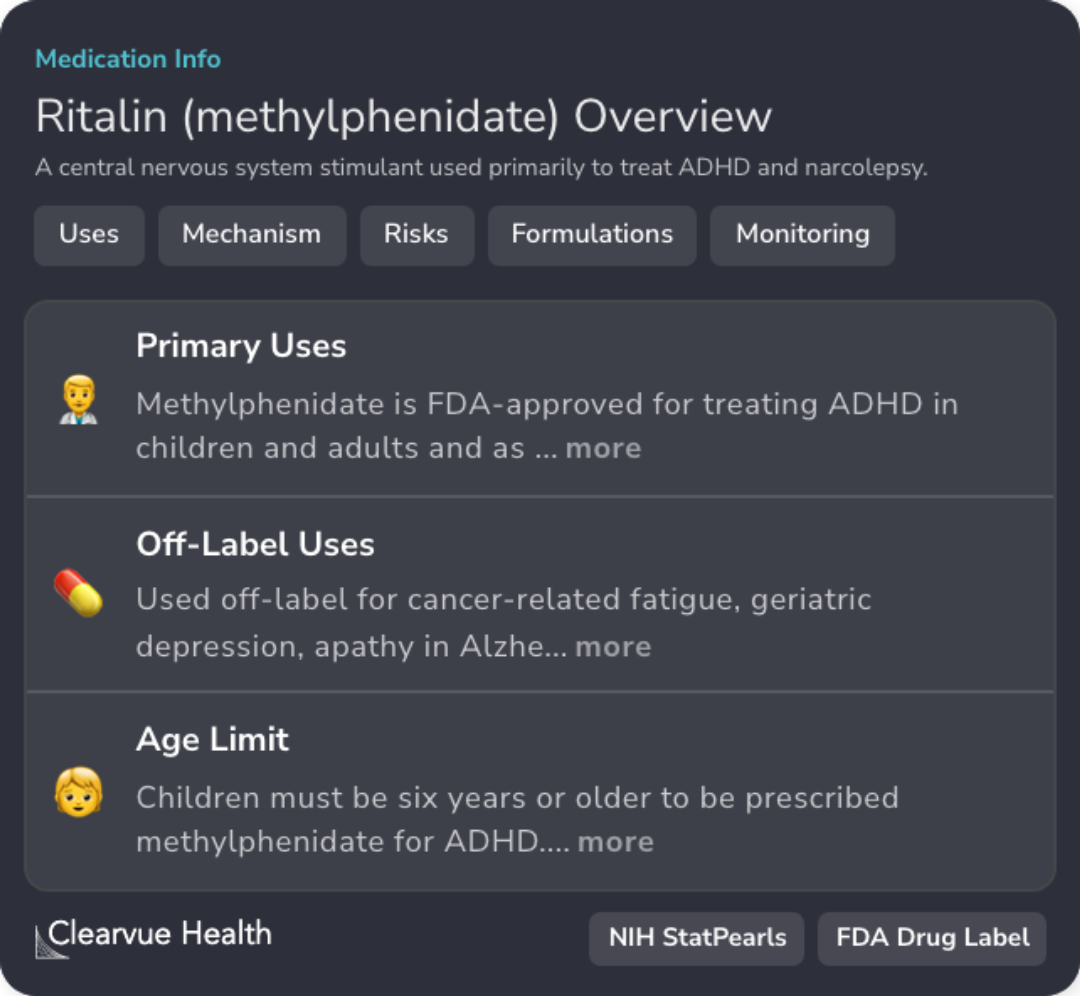
Professional Guide
Expert Opinion: Methylphenidate Enhances Working Memory
In line with the findings on the neuroanatomical impact of methylphenidate on working memory, current professional recommendations offer insight into the diagnostic and treatment protocols for ADHD.
The guidelines indicate that ADHD diagnosis can apply to preschool-aged children, enhancing the understanding of its early onset. Screening for comorbid conditions, such as anxiety and developmental disorders, is vital in the evaluation of ADHD.
Behavioral interventions take precedence as the first-line treatment for preschool children.
However, if behavioral interventions prove insufficient, methylphenidate is recommended for more substantial improvement.
Stimulant medications, including methylphenidate, are documented to have a strong effect size and are generally well tolerated by adults.
Additionally, combining stimulant medication with cognitive behavioral therapy (CBT) enhances treatment efficacy in adults. Monitoring cardiovascular health before starting stimulant treatment is also advised.
The guidelines indicate that ADHD diagnosis can apply to preschool-aged children, enhancing the understanding of its early onset. Screening for comorbid conditions, such as anxiety and developmental disorders, is vital in the evaluation of ADHD.
Behavioral interventions take precedence as the first-line treatment for preschool children.
However, if behavioral interventions prove insufficient, methylphenidate is recommended for more substantial improvement.
Stimulant medications, including methylphenidate, are documented to have a strong effect size and are generally well tolerated by adults.
Additionally, combining stimulant medication with cognitive behavioral therapy (CBT) enhances treatment efficacy in adults. Monitoring cardiovascular health before starting stimulant treatment is also advised.
Evidence Summary
ADHD Subtypes: Cognitive Differences and Self-Esteem
Attention-deficit hyperactivity disorder (ADHD) features diverse symptoms and cognitive deficits that can vary by subtype.
A study of 139 children classified into hyperactive (ADHD-H), inattentive (ADHD-I), and combined (ADHD-C) subtypes based on specific diagnostic tools revealed distinct cognitive profiles.
Notably, working memory was the most compromised across all subtypes, with ADHD-I showing the poorest cognitive scores.
Self-esteem levels also varied, correlating positively with cognitive abilities and differing among subtypes.
A study of 139 children classified into hyperactive (ADHD-H), inattentive (ADHD-I), and combined (ADHD-C) subtypes based on specific diagnostic tools revealed distinct cognitive profiles.
Notably, working memory was the most compromised across all subtypes, with ADHD-I showing the poorest cognitive scores.
Self-esteem levels also varied, correlating positively with cognitive abilities and differing among subtypes.
Evidence Summary
Methylphenidate's Impact on ADHD Brain Activity
Methylphenidate, a medication for ADHD, enhances brain activity tied to attention.
Researchers used brain imaging to observe how this medication affects attention-related regions in people with ADHD.
They found notable changes in neural activity after taking the medication.
Methylphenidate effectively improves focus and attention in those with ADHD by altering specific brain areas.
Researchers used brain imaging to observe how this medication affects attention-related regions in people with ADHD.
They found notable changes in neural activity after taking the medication.
Methylphenidate effectively improves focus and attention in those with ADHD by altering specific brain areas.
Evidence Summary
Methylphenidate's Role in Enhancing Cognitive Functions
Methylphenidate, known for treating ADHD, enhances cognitive functions.
Backed by research, it aids in improving attention, focus, and mental performance.
This medication shows significant improvements in cognitive abilities, particularly in individuals with ADHD.
Research highlights its positive impact on attention and overall mental performance.
Backed by research, it aids in improving attention, focus, and mental performance.
This medication shows significant improvements in cognitive abilities, particularly in individuals with ADHD.
Research highlights its positive impact on attention and overall mental performance.
